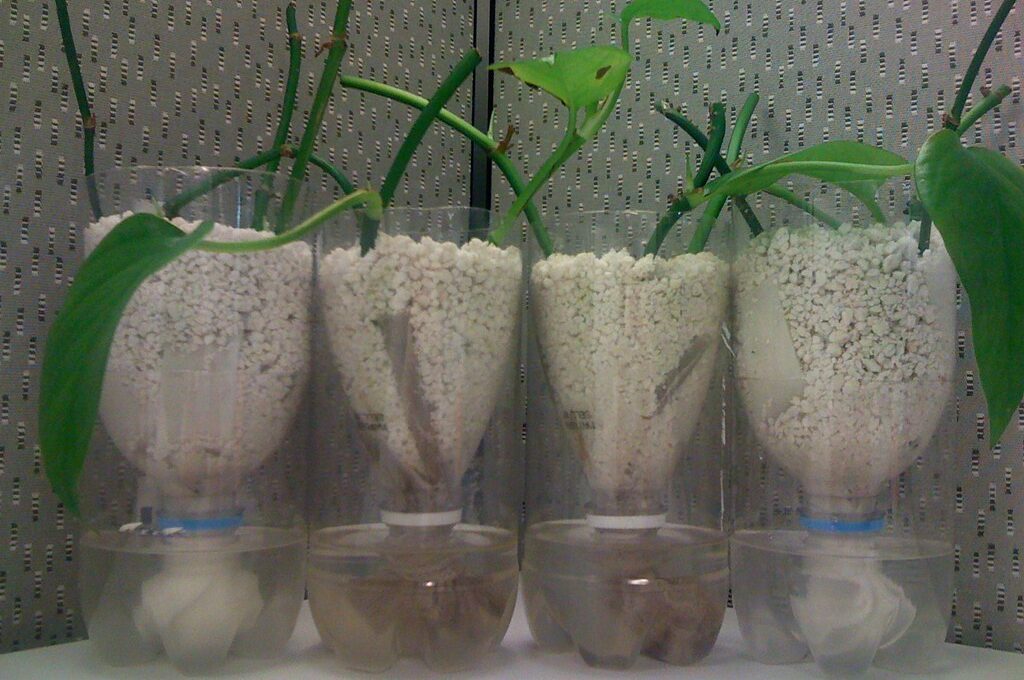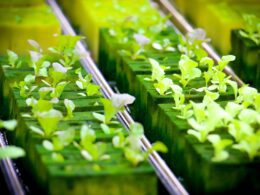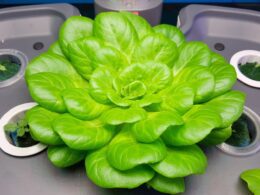Are you interested in growing plants quickly and efficiently? If so, hydroponics might be the way to go.
Hydroponics is a method of growing plants without soil, using a nutrient-rich water solution instead. This technique has several advantages over traditional soil-based gardening, including faster growth rates, higher yields, and less water usage.
One of the most significant advantages of hydroponics is that it allows plants to grow faster than they would in soil. This is because the plants have direct access to all the nutrients they need, without having to compete with other plants for resources.
Additionally, hydroponic systems can be optimized to provide the perfect growing environment for each type of plant, including the right temperature, humidity, and light levels. If you’re looking to maximize your plant growth and get results quickly, hydroponics might be the perfect solution for you.
Overview of Hydroponics and its Advantages
You’ll be amazed at how quickly and efficiently you can cultivate plants without soil through the innovative technique of hydroponics, which offers a range of benefits over traditional farming methods.
Hydroponics is a method of growing plants in water-based, nutrient-rich solutions, eliminating the need for soil. The practice of hydroponics dates back to ancient civilizations, including the Aztecs and Babylonians.
Today, different types of hydroponic systems are used, such as the deep water culture, nutrient film technique, and aeroponics. The deep water culture system involves suspending plant roots in a nutrient solution, while the nutrient film technique uses a thin layer of nutrient solution flowing over the roots. Aeroponics, on the other hand, involves misting the roots with a nutrient solution. These systems allow for more efficient use of water and nutrients, faster growth rates, and higher yields.
Hydroponics has several advantages over traditional soil-based farming. It reduces water usage, eliminates soil-borne pests and diseases, and allows for the ability to grow crops in areas with poor soil quality. Plus, hydroponic systems allow for year-round cultivation and the ability to grow crops in vertical spaces, making it an ideal technique for urban farming.
With hydroponics, you can grow a variety of plants, including fruits, vegetables, herbs, and flowers, all while enjoying the benefits of a sustainable, efficient, and safe growing method.
Factors Affecting Plant Growth in Hydroponics
The growth of plants in hydroponics can be influenced by a myriad of factors, such as nutrient levels, pH balance, and lighting conditions. Maintaining the right pH balance is crucial in hydroponics since it affects the plant’s ability to absorb nutrients.
A pH level of 5.5 to 6.5 is ideal for most plants in hydroponics, including lettuce, tomatoes, and peppers. If the pH level is too low, plants won’t be able to absorb enough nutrients, while a high pH level can lead to nutrient lockout.
Another crucial factor that affects plant growth in hydroponics is the nutrient solution. The nutrient solution provides the necessary minerals and nutrients for the plants to grow. It’s essential to maintain the right nutrient levels in the solution, as too little or too much can harm the plants.
A balanced nutrient solution should contain the right mix of macronutrients such as nitrogen, phosphorus, and potassium, as well as micronutrients like iron, calcium, and magnesium. Proper lighting is also crucial for plant growth in hydroponics.
Plants need light to photosynthesize and grow. The right lighting conditions will ensure that plants grow healthy and strong. Most plants require at least 12 to 16 hours of light per day, which can be provided by fluorescent, LED, or high-intensity discharge (HID) lights.
In addition to the duration of light, the intensity and spectrum of light can also affect plant growth in hydroponics. A proper balance of blue and red spectrum light can promote plant growth and flowering. By maintaining the right pH balance, nutrient solution, and lighting conditions, you’ll be able to grow healthy and thriving plants in hydroponics.
Remember to check the pH level regularly and adjust the nutrient solution accordingly. Providing the right lighting conditions will also ensure that your plants grow healthy and strong. With these factors in mind, you’ll be able to enjoy an abundant harvest of fresh and nutritious produce.
What are the Best Hydroponic Plants for Beginners to Grow?
Hydroponics for beginners opens up a world of possibilities for growing plants without soil. Some ideal hydroponic plants for beginners include lettuce, herbs like basil and mint, and leafy greens such as spinach and kale. These plants are relatively low maintenance and adapt well to the controlled environment of a hydroponic system. Experimenting with these varieties can help beginners learn and gain confidence in their hydroponic gardening skills.
Fast-Growing Plants in Hydroponics
Looking for plants that thrive in a hydroponic system and provide a quick harvest? Check out this section on fast-growing options.
When it comes to hydroponics, you want plants that grow quickly and efficiently. Luckily, there are several top choices that are perfect for hydroponic setups, including lettuce varieties and microgreens.
Lettuce varieties are an excellent choice for hydroponics because they grow quickly and can be harvested multiple times. Plus, they don’t take up much space, making them perfect for small hydroponic setups. Some of the best lettuce varieties for hydroponics include butterhead, romaine, and looseleaf lettuce.
Microgreens are another great option for hydroponic setups. These tiny plants are packed with nutrients and can be harvested in as little as two weeks. Plus, they come in a variety of flavors, including spicy arugula, sweet basil, and tangy mustard. Some of the most popular microgreens for hydroponics include sunflower, pea shoots, and wheatgrass.
So, if you’re looking to get a quick harvest from your hydroponic system, consider planting lettuce varieties and microgreens. These fast-growing options are perfect for hydroponics and will provide you with a bountiful harvest in no time.
Techniques for Maximizing Yield and Efficiency
Maximizing yield and efficiency in hydroponic systems requires implementing advanced techniques and strategies for optimal plant growth and productivity. One such technique is vertical farming, which involves stacking multiple layers of plants on top of each other to maximize space and yield. This technique can significantly increase the number of plants grown in a given area and reduce the amount of water and nutrients required.
By using vertical farming, you can grow more plants in less time, resulting in higher yields and greater productivity. Another crucial aspect of maximizing yield and efficiency in hydroponics is nutrient management. Proper nutrient management involves maintaining the correct balance of essential nutrients in the water solution used to nourish the plants.
This can be achieved by using high-quality nutrient solutions that are specifically formulated for hydroponic systems. Additionally, regular monitoring and adjustment of nutrient levels are necessary to ensure optimal plant growth and productivity. By implementing effective nutrient management strategies, you can enhance the overall health and yield of your hydroponic plants.
In conclusion, maximizing yield and efficiency in hydroponics requires advanced techniques and strategies, including vertical farming and nutrient management. By utilizing these techniques, you can achieve optimal plant growth and productivity, resulting in higher yields and greater overall success in your hydroponic endeavors. So, take the time to implement these strategies in your hydroponic system, and you’ll be amazed at the results.
Conclusion and Future of Hydroponics
We can’t deny that hydroponics is the future of sustainable agriculture, offering a boundless potential for innovation and growth. With vertical farming innovations, hydroponics has taken agriculture to new heights, quite literally.
The benefits of hydroponics are many – higher yields, more efficient use of resources, and less impact on traditional agriculture. Vertical farming, a type of hydroponics, is a game-changer in many ways. By stacking layers of crops, growers can maximize space, and grow more plants per square foot.
This technique has already revolutionized the way we grow food in urban areas. It enables us to grow fresh produce right in the heart of cities, reducing transportation costs and increasing access to healthy food. The impact of hydroponics on traditional agriculture is another reason why this method is gaining popularity.
With climate change and decreasing arable land, we need to find ways to feed the growing population. Hydroponics offers a viable solution that can work in any environment, whether it’s in a desert or an urban area. It’s also more sustainable than traditional agriculture, as it uses less water and fertilizer.
With all these benefits, it’s no wonder that hydroponics is here to stay.
Frequently Asked Questions
What is the best hydroponic system for beginners?
Looking to start growing herbs at home? Hydroponics might be the perfect solution for you!
There are several types of hydroponic systems available for beginners, including the drip system and the deep water culture system.
One of the biggest benefits of hydroponics is that it allows for faster growth and higher yields than traditional soil-based gardening. Plus, with hydroponics, you don’t have to worry about pests or soil-borne diseases.
It’s a great way to get fresh, homegrown herbs without all the fuss. So why not give it a try and see the benefits for yourself?
How much does it cost to set up a hydroponic system?
Looking to set up a hydroponic system but worried about the cost? There are plenty of budget-friendly options available, including DIY hydroponic systems.
With a little bit of research and creativity, you can build a system that fits your needs and your budget. Whether you’re growing herbs, vegetables, or even flowers, hydroponics can be a great way to get started.
And with the right setup, you can grow plants faster and more efficiently than traditional methods. So why not explore your options and see what you can create?
With a little bit of planning and some smart shopping, you can have a thriving hydroponic garden in no time.
Is it necessary to use artificial lighting in hydroponics?
If you’re considering starting a hydroponic system, you may be wondering if it’s necessary to use artificial lighting. While there are pros and cons to using artificial lighting, there are also natural alternatives that can work just as well.
One of the benefits of using natural lighting is that it’s free and doesn’t use any extra electricity. However, natural lighting can be unpredictable and may not provide enough light for certain plants.
Artificial lighting, on the other hand, can provide consistent light and can be adjusted to meet the needs of your plants. The downside is that it can be expensive to purchase and run.
Ultimately, the decision to use artificial lighting or natural alternatives will depend on your specific needs and preferences.
Can hydroponic plants be grown without any pesticides or herbicides?
Looking for a way to grow your own produce without the use of pesticides and herbicides? Look no further than organic hydroponics!
With alternative solutions like natural pest control methods and companion planting, it’s possible to grow healthy, vibrant plants without the use of harmful chemicals.
Plus, hydroponics allows for precise nutrient delivery, so you can ensure your plants are getting the exact nutrients they need to thrive.
So why not try your hand at organic hydroponics and enjoy the peace of mind that comes with knowing your food is safe and healthy to eat?
How often do you need to change the nutrient solution in a hydroponic system?
To keep your hydroponic plants thriving, it’s important to change the nutrient solution regularly. The frequency of nutrient changes in hydroponics depends on the type of plant you’re growing, the size of your system, and the quality of your water. Generally, it’s recommended to change the solution every two to three weeks.
Neglecting to do so can lead to a buildup of minerals and toxins that can harm your plants. The nutrient solution plays a vital role in plant growth, providing the necessary nutrients for healthy development. By regularly changing the solution, you can ensure that your plants are receiving the optimal amount of nutrients, leading to faster growth and a bountiful harvest.
Conclusion
Congratulations! You now know the fastest-growing plants in hydroponics and the techniques to maximize yield and efficiency.
With its advantages such as conserving water and space, hydroponics is becoming more popular. In the future, hydroponics can potentially be a solution to food scarcity and sustainability issues.
By using technology and innovation, hydroponics can be developed into a more efficient and accessible way of growing plants. So, keep on exploring and experimenting with hydroponics. Who knows, you might discover the next breakthrough in plant growth!









